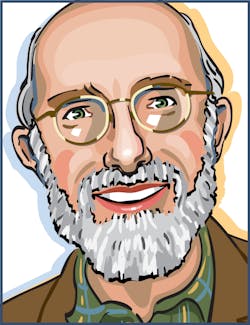A tribute to Charles Kao, the father of fiber-optic communications

Charles Kuen Kao, who received the 2009 Nobel Prize in Physics "for groundbreaking achievements concerning the transmission of light in fibers for optical communication," died on September 23, 2018, in Hong Kong. His work transformed the laser and optical industry—and by making broadband telecommunications possible, he also transformed the world. We have lost a giant.
Trained in microwave electronics, Kao developed his proposal for fiber-optic communications while working at Standard Telecommunications Laboratories (STL) in Harlow, England. His initial goal was to develop a new technology for links of about 10 km between local telephone exchanges, a market niche important in Britain. He calculated that would require glass fibers with attenuation of about 20 dB/km—much clearer than commercial optical glass. When Kao asked how clear glass could be made, Harold Rawson of the University of Sheffield told him that purification should reduce losses below 20 dB. That led to the landmark paper that Kao wrote with George Hockham, proposing transmission through single-mode fiber should reach 1 GHz in bandwidth and published in 1966. Laser Focus World reported Kao's work in the April 1, 1966 issue.
Clad optical fibers had been invented a decade earlier, and their main uses were in bundles for medical and military imaging that were short enough to allow attenuation of a decibel per meter. Telecommunications required a huge improvement. Kao first obtained samples of the purest glass available, fused silica, which was made by burning silicon tetrachloride vapor in an oxy-hydrogen flame. The loss was so low that he found it hard to measure, but eventually he obtained an extraordinarily low value between 5 and 0 dB/km in 1969. At the time, only STL, the British Post Office (which operated the country's phone network), and the Corning Glass Works—which had invented fused silica in the 1930s—were investigating fiber communications. Kao traveled the globe encouraging other labs to get into the field.
Light-guiding fibers were a challenge because they required high- and low-index glasses. A Corning team led by Robert Maurer made low-loss fibers by using titanium-doped silica developed for bakeware as the high-index core and lower-index pure silica for the cladding. They reported 17 dB/km titanium-doped fibers in 1970, and within a couple of years reduced attenuation to around 2 dB/km and improved fiber durability by doping the core with germanium rather than titanium.
At the time, private and public telephone monopolies were gearing up to replace chains of microwave relays for long-haul transmission with buried millimeter waveguides transmitting at 60 GHz. Bell Labs also was looking to a future generation of hollow optical waveguides to transmit laser beams when even more capacity was needed. The fiber-optic revolution that Kao launched blew both technologies away in the 1970s. The first fiber links between telephone switching offices were deployed in 1977. The world watched the 1980 Winter Olympics in Lake Placid, NY through an experimental fiber link installed by Bell Labs. Through the 1980s, fiber links became the backbone of the global telecommunications network, using the single-mode fibers that Kao had advocated in 1966.
Telephony was a big industry in the 1980s, and it meant a big market for the laser and optics industry. The need for high-speed light sources for optical communication pushed the development of long-lived diode lasers, which soon found applications in CD players and elsewhere. By the 1990s, the rapid growth of the Internet led to a seemingly insatiable thirst for bandwidth that drove development of fiber amplifiers and wavelength-division multiplexing. Those optical technologies also had spinoffs such as fiber lasers that have driven further growth of the laser industry.
That remarkable success of fiber communications owes much to Kao, whose vision pushed fiber technology far beyond the limits of the early 1960s. His push came at the right time, as advances in materials improved glasses and semiconductors, and advances in electronics and computers were building a new demand for communications. Others followed.
In later years, Kao became an elder statesman and visionary. After working at STL and its parent ITT, he became the vice-chancellor of the Chinese University of Hong Kong in 1987 until he retired in 1996. Sadly, he began to suffer from Alzheimer's disease in the mid-2000s, and his wife Gwen had to speak in his place when he received the Nobel Prize. In 2010, they established the Charles K. Kao Foundation for Alzheimer's Disease to increase public understanding of the disease.

Jeff Hecht | Contributing Editor
Jeff Hecht is a regular contributing editor to Laser Focus World and has been covering the laser industry for 35 years. A prolific book author, Jeff's published works include “Understanding Fiber Optics,” “Understanding Lasers,” “The Laser Guidebook,” and “Beam Weapons: The Next Arms Race.” He also has written books on the histories of lasers and fiber optics, including “City of Light: The Story of Fiber Optics,” and “Beam: The Race to Make the Laser.” Find out more at jeffhecht.com.